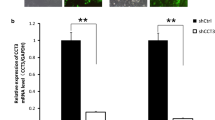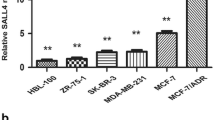Abstract
This study aims to investigate the effects of CXCR7-shRNA on TRAIL-mediated apoptosis and suppression of invasive migration and the underlying mechanisms. (1) We constructed CXCR-7-shRNA lentiviral vectors and confirmed their silencing efficiency in MCF-7 cells by RT-PCR analysis. (2) The effects of CXCR7 and/or TRAIL on cell proliferation were examined by MTT assay. (3) Trans well invasion assay was used to examine the effects of CXCR7 silencing and/or TRAIL on MCF-7 cell invasive migration. (4) Expression of Caspase-3, and Caspase-8, and MMP-2 and MMP-9 proteins was examined by Western blot analysis. (1) Viral titers were 2.95 × 108 TU/ml, 3.01 × 108 TU/ml, 3.26 × 108 TU/ml, and 3.08 × 108 TU/ml, respectively. (2) CHXR7 shRNAs markedly decreased CXCR7 mRNA expression in MCF-7 cells, among which CXCR7-shRNA-1 showed significantly higher rate of inhibition (P < 0.05). (3) Combination of TRAIL and CXCR7-shRNA-1 resulted in marked suppression of cell proliferation in time-dependent manner (P < 0.05). (4) Cell invasion capacity was inhibited in each experimental group as compared to blank control group at 48 h post treatments (P < 0.05). Among them, combination of TRAIL and CXCR7-shRNA had the highest inhibitory effect (P < 0.05). (5) Western blot analysis indicated that TRAIL alone does not affect CXCR7 expression, but either TRAIL + CXCR7 shRNA or CXCR7 shRNA alone markedly suppressed CXCR7 protein expression. Furthermore, combination of TRAIL and CXCR-7-shRNA significantly increased Caspase-3 and Caspase-8 expression and decreased MMP-2 and MMP-9 expression (P < 0.05). Knock-down of CXCR-7 expression leads to augmented TRAIL-mediated suppression of MCF-7 cell proliferation and invasion.








Similar content being viewed by others
References
De Luca A, D’Alessio A, Gallo M, Maiello MR, Bode AM, Normanno N. Src and CXCR4 are involved in the invasiveness of breast cancer cells with acquired resistance to lapatinib. Cell Cycle. 2014;13(1):148–56. doi:10.4161/cc.26899.
Satelli A, Mitra A, Cutrera JJ, Devarie M, Xia X, Ingram DR, et al. Universal marker and detection tool for human sarcoma circulating tumor cells. Cancer Res. 2014;74(6):1645–50. doi:10.1158/0008-5472.CAN-13-1739.
Yang Q, Zhang F, Ding Y, Huang J, Chen S, Wu Q, et al. Antitumour activity of the recombination polypeptide GST-NT21MP is mediated by inhibition of CXCR4 pathway in breast cancer. Br J Cancer. 2014;110(5):1288–97. doi:10.1038/bjc.2014.1.
Satelli A, Brownlee Z, Mitra A, Meng QH, Li S. Circulating tumor cell enumeration with a combination of epithelial cell adhesion molecule- and cell-surface vimentin-based methods for monitoring breast cancer therapeutic response. Clin Chem. 2015;61(1):259–66. doi:10.1373/clinchem.2014.228122.
Satelli A, Mitra A, Brownlee Z, Xia X, Bellister S, Overman MJ, et al. Epithelial-mesenchymal transitioned circulating tumor cells capture for detecting tumor progression. Clin Cancer Res: Off J Am Assoc Cancer Res. 2015;21(4):899–906. doi:10.1158/1078-0432.CCR-14-0894.
Holland JD, Gyorffy B, Vogel R, Eckert K, Valenti G, Fang L, et al. Combined Wnt/beta-catenin, Met, and CXCL12/CXCR4 signals characterize basal breast cancer and predict disease outcome. Cell Reports. 2013;5(5):1214–27. doi:10.1016/j.celrep.2013.11.001.
Sosinska-Mielcarek K, Duchnowska R, Winczura P, Badzio A, Majewska H, Lakomy J, et al. Immunohistochemical prediction of brain metastases in patients with advanced breast cancer: the role of Rad51. Breast. 2013;22(6):1178–83. doi:10.1016/j.breast.2013.08.011.
Hung CS, Su HY, Liang HH, Lai CW, Chang YC, Ho YS, et al. High-level expression of CXCR4 in breast cancer is associated with early distant and bone metastases. Tumour Biol: J Int Soc Oncodev Biol Med. 2014;35(2):1581–8. doi:10.1007/s13277-013-1218-9.
Yang P, Liang SX, Huang WH, Zhang HW, Li XL, Xie LH, et al. Aberrant expression of CXCR4 significantly contributes to metastasis and predicts poor clinical outcome in breast cancer. Curr Mol Med. 2014;14(1):174–84.
Ying J, Xu Q, Zhang G, Liu B, Zhu L. The expression of CXCL12 and CXCR4 in gastric cancer and their correlation to lymph node metastasis. Med Oncol. 2012;29(3):1716–22. doi:10.1007/s12032-011-9990-0.
Wang Y, Li G, Stanco A, Long JE, Crawford D, Potter GB, et al. CXCR4 and CXCR7 have distinct functions in regulating interneuron migration. Neuron. 2011;69(1):61–76. doi:10.1016/j.neuron.2010.12.005.
Liu L, Zhao X, Zhu X, Zhong Z, Xu R, Wang Z, et al. Decreased expression of miR-430 promotes the development of bladder cancer via the upregulation of CXCR7. Mol Med Reports. 2013;8(1):140–6. doi:10.3892/mmr.2013.1477.
Schanz A, Baston-Bust D, Krussel JS, Heiss C, Janni W, Hess AP. CXCR7 and syndecan-4 are potential receptors for CXCL12 in human cytotrophoblasts. J Reprod Immunol. 2011;89(1):18–25. doi:10.1016/j.jri.2011.01.016.
Xue TC, Chen RX, Ren ZG, Zou JH, Tang ZY, Ye SL. Transmembrane receptor CXCR7 increases the risk of extrahepatic metastasis of relatively well-differentiated hepatocellular carcinoma through upregulation of osteopontin. Oncol Rep. 2013;30(1):105–10. doi:10.3892/or.2013.2442.
Ren J, Zhang Y, Cai H, Ma H, Zhao D, Zhang X, et al. RNAi targeting GPR4 influences HMEC-1 gene expression by microarray analysis. Int J Clin Exp Med. 2014;7(3):607–15.
Zeng Z, Zhang C, Chen J. Lentivirus-mediated RNA interference of DC-STAMP expression inhibits the fusion and resorptive activity of human osteoclasts. J Bone Miner Metab. 2013;31(4):409–16. doi:10.1007/s00774-013-0434-0.
Lin Y, Cui M, Xu T, Yu W, Zhang L. Silencing of cyclooxygenase-2 inhibits the growth, invasion and migration of ovarian cancer cells. Mol Med Reports. 2014;9(6):2499–504. doi:10.3892/mmr.2014.2131.
Liu L, Zhang N, Liu J, Min J, Ma N, Liu N, et al. Lentivirus-mediated siRNA interference targeting SGO-1 inhibits human NSCLC cell growth. Tumour Biol: J Int Soc Oncodev Biol Med. 2012;33(2):515–21. doi:10.1007/s13277-011-0284-0.
Sun XY, Nong J, Qin K, Lu H, Moniri MR, Dai LJ, et al. MSC(TRAIL)-mediated HepG2 cell death in direct and indirect co-cultures. Anticancer Res. 2011;31(11):3705–12.
Elbashir SM, Lendeckel W, Tuschl T. RNA interference is mediated by 21- and 22-nucleotide RNAs. Genes Dev. 2001;15(2):188–200.
Mohan RR, Rodier JT, Sharma A. Corneal gene therapy: basic science and translational perspective. Ocular Surface. 2013;11(3):150–64. doi:10.1016/j.jtos.2012.10.004.
Bratton SB, MacFarlane M, Cain K, Cohen GM. Protein complexes activate distinct caspase cascades in death receptor and stress-induced apoptosis. Exp Cell Res. 2000;256(1):27–33. doi:10.1006/excr.2000.4835.
Sprick MR, Weigand MA, Rieser E, Rauch CT, Juo P, Blenis J, et al. FADD/MORT1 and caspase-8 are recruited to TRAIL receptors 1 and 2 and are essential for apoptosis mediated by TRAIL receptor 2. Immunity. 2000;12(6):599–609.
Moulin M, Arrigo AP. Caspases activation in hyperthermia-induced stimulation of TRAIL apoptosis. Cell Stress Chaperones. 2008;13(3):313–26. doi:10.1007/s12192-008-0027-3.
Movsesyan VA, Stoica BA, Yakovlev AG, Knoblach SM, Lea PM, Cernak I, et al. Anandamide-induced cell death in primary neuronal cultures: role of calpain and caspase pathways. Cell Death Differ. 2004;11(10):1121–32. doi:10.1038/sj.cdd.4401442.
Deryugina EI, Quigley JP. Matrix metalloproteinases and tumor metastasis. Cancer Metastasis Rev. 2006;25(1):9–34. doi:10.1007/s10555-006-7886-9.
Madsen MA, Deryugina EI, Niessen S, Cravatt BF, Quigley JP. Activity-based protein profiling implicates urokinase activation as a key step in human fibrosarcoma intravasation. J Biol Chem. 2006;281(23):15997–6005. doi:10.1074/jbc.M601223200.
Mehlen P, Puisieux A. Metastasis: a question of life or death. Nat Rev Cancer. 2006;6(6):449–58. doi:10.1038/nrc1886.
Acknowledgments
We gratefully acknowledge support from the First Clinical Hospital of Liaoning Medical University Youth Fund (No. FY2011-10), the Liaoning Medical University youth fund project (NO. Y2011Z003), and support from Science and Technology Department of Liaoning Province (NO. 2012225019). We gratefully acknowledge support from President Funding of Liaoning Medical University (No. XZJJ20140206).
Conflict of interest
None
Author information
Authors and Affiliations
Corresponding author
Additional information
Weiran Gao and Xifan Mei are the joint first authors
Rights and permissions
About this article
Cite this article
Gao, W., Mei, X., Wang, J. et al. ShRNA-mediated knock-down of CXCR7 increases TRAIL-sensitivity in MCF-7 breast cancer cells. Tumor Biol. 36, 7243–7250 (2015). https://doi.org/10.1007/s13277-015-3432-0
Received:
Accepted:
Published:
Issue Date:
DOI: https://doi.org/10.1007/s13277-015-3432-0




